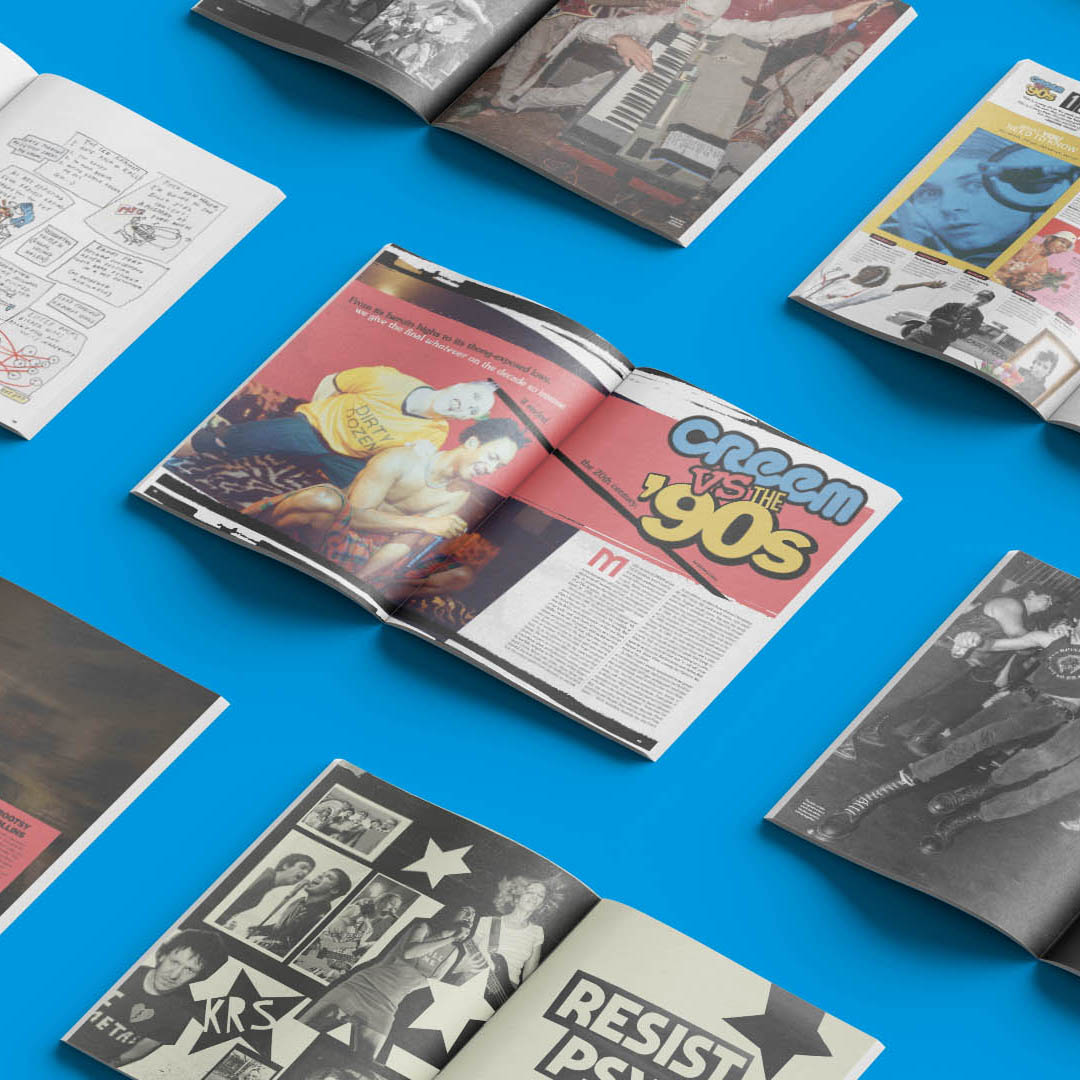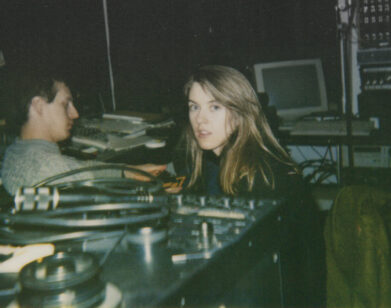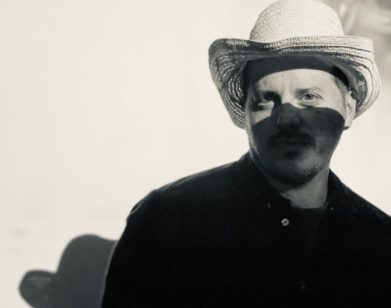NINETIES
How Creem Magazine Came Back to Life With Its Most Ambitious Issue Yet
Can a legacy print magazine known for covering artists like Lou Reed establish a new foothold in the era where most music “journalism” consists of TikTok track reactions and articles meant to appease scary stans? The team at Creem, the prestigious Detroit-based rock magazine that ran throughout the ‘70s and ‘80s, aren’t totally sure, but they’re willing to try. “We’ve been around for a year,” says writer and Creem editor-at-large Zachary Lipez of the magazine’s return. “We must continuously justify our existence. Not wanting to die is a great incentive to do the best work you can.” When I spoke to Lipez via Zoom, he had the mix of wry jadedness and earnest enthusiasm common for a longtime music journalist, joking that the return of Creem in today’s media climate was “insane” and “foolhardy.”
Creem relaunched in June 2022, with an emphasis on its archive for subscribers, like their array of Lester Bang pieces and cover stories with Elton John, Blondie, and Mick Jagger, as well as a plan for quarterly print issues, bringing a necessary balance of snark and genuine passion to contemporary music coverage. But the magazine, whose initial run ended in 1989, never had a chance to bring that sensibility to the music that flourished in the ensuing decade, like grunge, rap rock, and the riot grrrl scene.
“There’s always been this thing hanging in the background of what we missed and how to talk about it,” says Lipez. “We landed on what was always the simplest and best solution, which is just come at it face-forward as best we could.”
Those conversations led to Creem vs. the ‘90s, the most ambitious issue of the publication’s new incarnation, which includes a wide-ranging feature on Kill Rock Stars, an endearing Q&A with Sugar Ray’s Mark McGrath, an interview with Alicia Bognanno of Bully, a band keeping the ‘90s alternative ethos alive, and a freewheeling conversation with Ringo Starr that gave the magazine an unexpected viral moment. Just before the special issue dropped, I spoke to Zachary Lipez about assessing the decade the Creem way, what success means to a print magazine in 2023, and where Creem sits on the 30 Rock character alignment chart.
———
GRANT RINDNER: Creem historically occupies an interesting niche within music journalism, and bringing it back at this time is a really cool and ambitious endeavor.
ZACHARY LIPEZ: “Ambitious” is a kind word. It’s insane, foolhardy, but we’re doing it. It’s been a success so far, and I imagine we will have replaced all media by this time two to three years from now.
RINDNER: How did you get involved with this new iteration of Creem and when did the idea of doing this ’90s catchall take shape?
LIPEZ: My involvement with Creem started while it was still being formulated through Fred Pessaro, who has always been a mentor and patron of mine. He’s always supported me when others have not. When John Martin was coordinating with JJ Kramer to form [the magazine], they brought me in just to see how I could help. Making coffee, looking pretty. I’ve been doing music writing for a number of years, though I got started pretty late in the game. [I wanted] to make sure that I completely washed out as a musician first. I’m very grateful that they’ve taken me along on this ride. We’ve been toying around with themed issues, and there’s always been this thing hanging in the background of what we missed and how to talk about it, and whether to do it in a jokey way, pretending that time stopped when we were away. We landed on what was always the simplest and best solution, which is to come at it face-forward.
RINDNER: There’s a Tracy Jordan 30 Rock line where he goes, “When I go to sleep, nothing happens in the world.” I think by doing it the way you have, it acknowledges how music coverage has changed instead of pretending the mechanisms through which we discuss music are unchanged.
LIPEZ: And we try to go with things as sort of a combination between Tracy Jordan and Jenna and Kenneth.
RINDNER: In terms of mixing new music coverage with ‘90s-centric topics like the J Dilla piece, how did the edit team go about selecting what modern artists fit in the issue?
LIPEZ: It’s two things. While we do themes, we’re also big fans of having our cake and really stuffing our face in it. We weren’t going to not cover some artists that we wanted to talk about in this issue, and we didn’t feel the need to make some huge leap. With something like Bully, it’s a very easy leap because sonically, she’s working within a tradition of ’90s rock. We had Sam McPheeters talk about Kill Rock Stars, which would go in any issue because that’s fucking wonderful. If you don’t have any guidelines, freedom can be a real son of a bitch. So if the theme helps us focus on what we’re doing, cool. If there’s somebody fascinating or a good writer that doesn’t really have any connection to the ’90s, that’s also fine.
RINDNER: You’ve got this section that’s catching up on each year in a truncated fashion. How were those conversations to decide what made the cut? Did they get heated?
LIPEZ: They did. A decade is already an arbitrary construct to say that rock music in America was this from this date to this date. You want to go into these things with a healthy amount of skepticism. Of course it got heated, because within the confines of nothing mattering, this shit matters. And if it were up to me, there would’ve been six pages devoted to Throwing Muses or something.
RINDNER: I hate the term, but it’s a very “voicey” magazine. You want people to be writing about things that they care about, so they’re going to put all of themselves in there.
LIPEZ: Say there’s a reader whose view of the ‘90s is just Smashing Pumpkins and this type of clothing and attitude. It’s not incorrect. Hopefully what we’ve accomplished here is covering that sort of thing, while also being like, “Here’s another way of looking at this widely discussed topic.”
RINDNER: In your mind, is this issue geared more towards people in their 40s who experienced this music in real time, or for younger listeners who may be more in the discovery phase?
LIPEZ: That’s an interesting question. I’m not trying to turn it around on you, but did you find it entertaining or useful in any way?
RINDNER: I did, definitely, but I also was a music magazine reader and there’s so much music in here that I’ve not heard. One of the things that I miss about music magazines and blogs is reading someone’s compelling description of a record before I’ve heard it and then getting to see how it sounds. Nowadays, so much of music coverage is the inverse, where you hear the thing first and then if you like it, you read about it.
LIPEZ: And you can’t just press a link on [a print magazine]. I want people my age to enjoy it, and there certainly are references that people who weren’t listening to the music at the time won’t get. But ideally, it would be a mix of that and curious people in their twenties. I think in a lot of music writing—and this is through no fault of anyone other than the oligarchical hedge fund managers—there is an assumption that the readership are the stupidest motherfuckers that ever walked the earth. It’s the sort of thinking where they think people won’t read anything over a thousand words. Except they do, especially with a print and a quarterly. There has to be an assumption that the reader likes music enough that they’re not going to be alienated [if they don’t get] a reference or a joke. They’ll pick up their phone and they’ll look up the band. We’re not suggesting anyone read this in a wifi-less room.
RINDNER: Right, it’s not a zine. It’s a magazine with advertisers that you hope has reach and accessibility.
LIPEZ: Yeah. I don’t want to go back to tending bar. My feet hurt.
RINDNER: There’s some stuff in this issue, like the Mark McGrath interview, that I feel the original run of Creem wouldn’t have necessarily included. Or if it did, the magazine would’ve covered it with a little more of an elbow-in-the-ribs, mocking tone.
LIPEZ: Creem was ending around the time that I started really consuming music media, so one of the joys of working with Creem has been going through the archives myself. One thing that really separated it from a lot of its contemporaries was its balance of the popular and the unpopular. They would write skeptical articles about Grand Funk Railroad, but they probably wrote about Grand Funk Railroad more than any other [outlet], and, in a lot of ways, loved it. I think the dividing line was they distrusted things that felt manufactured. The ’70s had certain blind spots. There are certain ways that it would discuss things that wouldn’t fly today, but with something like Mark McGrath, they would probably make jokes about how handsome he is, but I think the coverage would still be there.
RINDNER: That’s something that I feel like music coverage is lacking nowadays, because everything feels so driven by fandom. The writers are fans and people are scared of fans, so the coverage is either raving adulation or, every once in a while, someone saying, “This is craven and has no artistic value.” But there’s a whole under-exploited middle ground of being curious for curiosity’s sake.
LIPEZ: One of the advantages of being a quarterly and a print magazine is, in a moral self-righteous way, we do not have to indulge in that. We genuinely don’t even have to think about it, because by the time the stans find out where we live, we will have moved. You want to come at these things with a fair amount of skepticism, but also, Creem has been about [fandom] before it became a toxic term. None of us would be writing about any of these things if we didn’t love it. I’m grateful that we’re going to write about the things we want to write about, and hopefully we’re able to make fun of what we want to make fun of.
RINDNER: You can feel cultural coverage nowadays being positive, but also waiting to pounce when the narrative begins to shift. That’s not, in my experience, a terribly enjoyable place to write from.
LIPEZ: You write about small or mid-level artists because you like them, so you’re not going to be terribly negative. Why would you? You only know about them because you like them. Then with the larger artists, in the landscape today, they don’t need the music media in the slightest. If you set yourself up with a reputation that we’re always going to be insulting, then you’re just not going to cover anybody big because they’re just going to say, “Why would we do this?”
RINDNER: How did Creem balance the voices of various generations of rock fans?
LIPEZ: I think it’s a responsibility of editors to not fall in the trap of relying on the writers that you already know because then things are self-perpetuating. But we get a ton of pitches from a variety of people. I do think that finding people in their early 20s is increasingly difficult, not because they’re dumb or lazy or any of that bullshit, but because for a lot of them being a music writer isn’t even on their radar. Not because they don’t love music, but you contact someone who does amazing memes or a good YouTube channel and they’re game, but then you do have to explain to them, “Can you not pitch via voice text?” We have certain people that are intuitive choices, but when you look closer, it’s like, are these just the people that we DM on a regular basis?
RINDNER: Over the weekend I opened my Twitter and the top post was the “dudes rock” excerpt from Hether [Fortune]’s interview with Ringo Starr. When you have a contemporary magazine that is looking back, you can get those hilarious generation gap moments. Creem has published a handful of issues since its return, but this one feels particularly ambitious and buzzy. How will the team know that it had the impact you wanted?
LIPEZ: Here’s the thing, we’ve been around for a year. It’s a print quarterly. And again, this is not a negative. We must continuously justify our existence. I think that’s a good challenge. Not wanting to die is a great incentive to do the best work you can. We’ll know when we get more subscribers. You can’t get the magazine on the newsstand. We don’t do much advertising at all, and we pay writers fairly, so we need people to subscribe. But if getting subscriptions was our only intent, we’d be a much shittier magazine. So there has to be that balance of maintaining at least enough integrity to not go to sleep sobbing, but not so much that you don’t sell magazines.







